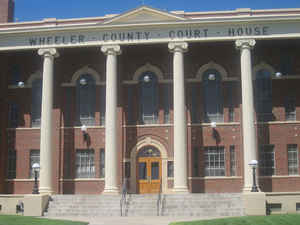Texas Counties
Texas is divided into two hundred and fifty-four counties, more than any other state. Texas was originally divided into municipalities, a unit of local government under Spanish and Mexican rule. When the Republic of Texas gained its independence in 1836, there were 23 municipalities, which became the original Texas counties. Many of these would later be divided into new counties. The most recent county to be created was Kenedy County in 1921. The most recent county to be organized was Loving County in 1931Wheeler County, Texas
Wheeler County Education, Geography, and History

Wheeler County is a county located in the state of Texas. Based on the 2010 census, its population was 5,410. Its county seat is Wheeler. The county was formed in 1876 and organized in 1879. It is named for Royall Tyler Wheeler, a chief justice of the Texas Supreme Court.
Etymology - Origin of Wheeler County Name
Royal Tyler Wheeler, the second Chief Justice of the Texas Supreme Court
Demographics:
County QuickFacts: CensusBureau Quick Facts
Wheeler County History
In 1876, the Texas State Legislature established Wheeler County. In 1879, Mobeetie was named the county seat. Mobeetie was then known as "Sweetwater," but this name should not be confused with the Sweetwater, which is the seat of Nolan County west of Abilene. A stone courthouse was erected from locally quarried materials in 1880 but was replaced by a wooden structure in 1888. The town of Wheeler was designated as the county seat in 1908. Officially formed in 1876, the county is named for Royal Tyler Wheeler, a chief justice of the Texas Supreme Court.
Handbook of Texas Online
The area that became Wheeler County was occupied by a Plains Apache culture, which was followed by a modern
Apache people, who in turn were displaced by the Kiowas and Comanches around A.D. 1700. The Kiowas and Comanches
dominated the Panhandle until they were finally defeated in the Red River War of
1874 and moved to reservations in Indian Territory during 1875 and 1876. Buffalo
hunters had begun moving into the area before the Indians were removed. In the spring of 1874 they established a
crude outpost, called Hidetown or Sweetwater, on Sweetwater Creek, in the northwestern part of what is now Wheeler
County. To curb Indian escapes from Indian Territory, in June 1875 the United States Army established a post near
Hidetown. It was named Fort Elliott in 1876 and remained operative until 1890, providing both protection and
economic benefits for newly arrived residents. In 1878 the first post office in the Panhandle was established there.
As the Indian threat diminished in 1875 and 1876, settlers began to congregate around Fort Elliott and Hidetown, and
in 1876 the Texas state legislature established Wheeler County from lands formerly assigned to the Bexar and Young
districts. As the buffalo were hunted out of existence, cattle ranching began to develop in the area, and former
buffalo hunters, discharged soldiers, and newly arriving ranchers settled into the county. In 1879 the local
residents petitioned for county organization. On April 12, 1879, Wheeler County became the first organized county in
the Panhandle, with fourteen other unorganized counties attached to it. The small camp of Sweetwater was chosen to
be the county seat; the settlement was renamed Mobeetie in 1880, when a post office was established there.
Throughout the second half of the 1870s and during the 1880s and 1890s, ranching and Fort Elliott dominated the
local economy. In 1890, when the United States agricultural census counted forty-six ranches or farms in the county,
almost 9,300 cattle and 1,700 sheep were reported, but only 400 acres were planted in corn, the county's most
important crop at that time. In 1900 there were 119 ranches or farms, and 33,000 cattle and 900 sheep were reported,
but only 600 acres were planted in corn and ten acres in cotton. For the most part, ranches in Wheeler County at
this time were relatively small compared to ranches in other Panhandle counties. Only the J-Buckle Ranch, in the
southeastern corner of the county, could be considered large. The United States census found 512 people living in
the county in 1880 and 778 in 1890. The population declined after Fort Elliott was closed about 1890, and by 1900
there were 636 people living there More at
Donald R. Abbe and John Leffler, "WHEELER COUNTY," Handbook of Texas Online (http://www.tshaonline.org/handbook/online/articles/hcw07),
accessed January 24, 2016. Uploaded on June 15, 2010. Published by the Texas State Historical Association.
Geography: Land and Water
As reported by the Census Bureau, the county has a total area of 915 square miles (2,371 km2), of which, 914
square miles (2,368 km2) of it is land and 1 square miles (3 km2) of it (0.12%) is water.
Neighboring Counties
Bordering counties are as follows:
- Hemphill County (north)
- Roger Mills County, Oklahoma (northeast)
- Beckham County, Oklahoma (east)
- Collingsworth County (south)
- Gray County (west)
Education







